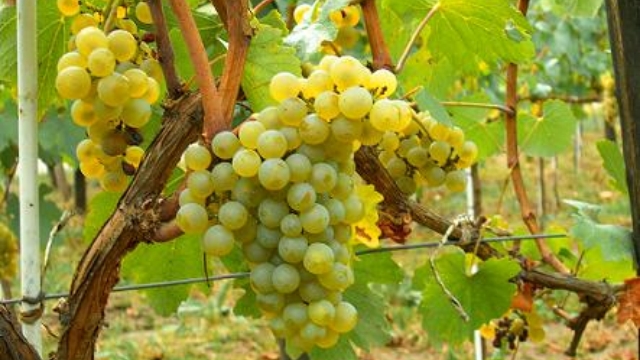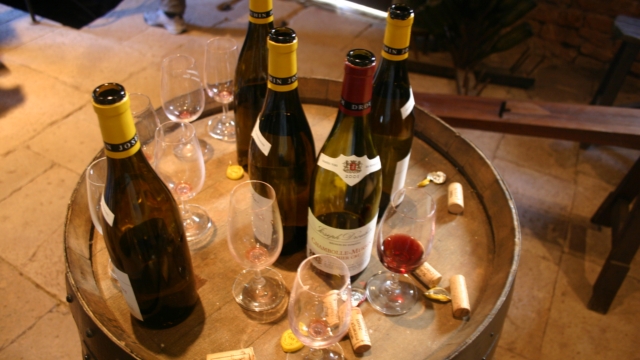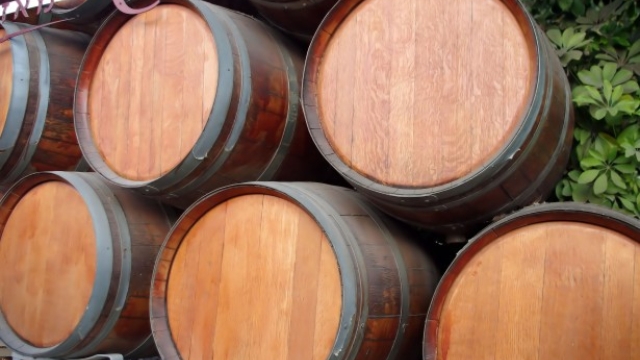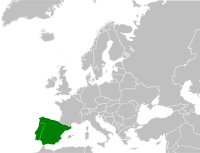That Useful Wine Site
Search, or just roll your cursor over the colored boxes farther below.click the “x” to dismiss Search-results block.




Advertisement:
Advertisement:
Quick page jumps:
(Synonyms: Aragón, Aragones, Aragonez, Arauxa, Boton de Gallo, Cencibel, Chinchillana, Chinchilyano, Escobera, Garnacho Foño, Grenache de Logrono, Jacibiera, Jacivera, Negra, Negra di Tinta de Nava, Tinta del Pais, Tinta de Toro, Tinta Madrid, Tinta Monteira, Tinta Monteiro, Tinta Roriz, Tinta Santiago, Tinto Aragónez, Tinto de Madrid, Tinto de Rioja, Tinto de Toro, Tinto del Pais, Tinto Fino, Ull de Liebre, Valdepeñas, Verdiell, Vid de Aranda)

Tempranillo is a red-wine grape originating millennia ago in the Iberian peninsula (today comprising Portugal and Spain). It is widely considered one of the dozen and a half or so “Noble wine grapes” of the world. Today, it is still a major grape in its homeland, but is also planted in nontrivial amounts in many other wine-making regions globally. It is often described as the signature grape of Spain, which may be an exaggeration, considering some of the others.
As with almost all wines of the Old World, monovarietal bottlings were traditionally rare; Tempranillo, however, has often been a dominant element in those regionally named blends in which it appears. Tempranillo wines are typically somewhat low in both sugar and acid, which is why other varieties are often blended with them. In the modern world, however, with emphasis shifting (especially in the New World) from regions to specific varietals, monovarietal bottlings are more common than formerly.
Tempranillo does not do well in hot climates, which is why it has long been cultivated mainly in the northern regions of Spain and Portugal. The main Spanish appellations for Tempranillo-based wines are Rioja and Ribera del Duero, though with the varietal’s increasing popularity, plantings elsewhere in Spain are appearing. In Portugal, it is not quite as major a player, but participates in the wines of central Alentejo and Douro. In the U.S., Tempranillo is emerging as the signature grape of the rapidly developing Texas wine industry; it is also grown in the usual other places, California, Oregon, and Washington State. Extensive plantings also exist in the wine-making countries of South America, Argentina and Chile, as well as in the emerging Mexican wine arena.
Tempranillo wines are typically quite dark in color. Its aromas and tastes are those of a major red wine: berry, tobacco, leather, vanilla, herb. Blends tend to make wines that are intended to be somewhat more fruity.
To quote Elizabeth Schneider, “Though most places in Europe focus on terroir or the soil and the flavor that derives from the vineyard, Rioja is more about the process of making it – the grapes used and how long the wine stays in a barrel determines quality.” Spanish Tempranillo wines have labelling that describes how the wnes were treated, which is usually a good clue to how well the vintner thought of them. Those are:
Joven: aged up to 12 months in oak; meant to be drunk young, and so essentially “lightweight” in all senses (though still satisfying).
Crianza: aged at least one year in oak (typically 1 to 1½ years) and at least one more year in bottle; what one might call “basic” Tempranillo, the everyday wine in its homeland, and often an excellent bargain.
Reserva: aged at least a year in oak (typically 1½ to 2 years) and at least 2 more years in bottle; these tend to be bigger and darker and more complex wines—“A Friday night wine” as Ms. Schneider puts it. Good bargains are still possible.
Gran Reserva: aged at least 24 months in oak and at least 36 more months in bottle; these are what the winemaker thinks are his best Tempranillos, and a Gran Reserva at any sort of civilized price is a good (and unusual) buy indeed.
At least in the Rioja appellation, whence much Spanish Tempranillo, there is now a significant divide between wineries making Tempranillo in a “traditional” manner and those making it in a “modern” manner, which some might call “internationalized”. You should try some of each style to see what your preference is.
Factoid: Tempranillo appeared in Iberia in the time of the Phoenician colonies there; the Phoenicians spread winemaking knowledge throughout their expansive culture.
Decent Tempranillos at reasonable prices abound. But with care, one can do better than “decent” abd still stay within reasonable budgetary and availability bounds—as the list below demonstrates.
• This wine’s Wine Searcher “Reviews” page.
• This wine’s CellarTracker review pages.
• Retail offers of this wine listed by Wine Searcher.
• Retail offers of this wine listed by 1000 Corks.
• This wine’s Wine Searcher “Reviews” page.
• This wine’s CellarTracker review pages.
• Retail offers of this wine listed by Wine Searcher.
• Retail offers of this wine listed by 1000 Corks.
• This wine’s Wine Searcher “Reviews” page.
• This wine’s CellarTracker review pages.
• Retail offers of this wine listed by Wine Searcher.
• Retail offers of this wine listed by 1000 Corks.
• This wine’s Wine Searcher “Reviews” page.
• This wine’s CellarTracker review pages.
• Retail offers of this wine listed by Wine Searcher.
• Retail offers of this wine listed by 1000 Corks.
• This wine’s Wine Searcher “Reviews” page.
CellarTracker does not seem to have a listing for this wine:
• This wine’s CellarTracker review pages.
• Retail offers of this wine listed by Wine Searcher.
• Retail offers of this wine listed by 1000 Corks.
Our nomination is the Victorino “Toro”, which retails for about $43 to $80.
• This wine’s Wine Searcher “Reviews” page.
• This wine’s CellarTracker review pages.
• Retail offers of this wine listed by Wine Searcher.
• Retail offers of this wine listed by 1000 Corks.
Advertisement:
Advertisement:
|
|
This site is one of The Owlcroft Company family of web sites. Please click on the link (or the owl) to see a menu of our other diverse user-friendly, helpful sites. |
|
| (Note: All Owlcroft systems run on Ubuntu Linux and we heartily recommend it to everyone—click on the link for more information). | ||
|
All content copyright © 2024 The Owlcroft Company
(excepting quoted material, which is believed to be Fair Use). |
This web page is strictly compliant with the W3C (World Wide Web Consortium) Extensible HyperText Markup Language (XHTML) Protocol v1.0 (Transitional) and the W3C Cascading Style Sheets (CSS) Protocol v3 — because we care about interoperability. Click on the logos below to test us!
This page was last modified on Saturday, 30 October 2021, at 11:26 pm Pacific Time.
Some Descriptions of Tempranillo Wines
“Tempranillo wines are ruby red in colour, while aromas and flavours can include berries, plum, tobacco, vanilla, leather and herb. Often making up as much as 90% of a blend, Tempranillo is less frequently bottled as a single varietal. Being low in both acidity and sugar content, it is most commonly blended with Grenache (known as Garnacha in Spain), Carignan (known as Mazuela in Spain), Graciano, Merlot and Cabernet Sauvignon. Blending the grape with Carignan makes a brighter and more acidic wine.”
[This entire article is recommended reading.]
“Tempranillo is best known as the dominant grape of red rioja, Spain’s most famous wine. To make a parallel with the most celebrated blended red wine in the world, red bordeaux, Tempranillo plays the Cabernet Sauvignon part while the much juicier, fruitier Garnacha (known in France as Grenache) plays the role of plumper blending partner Merlot. Tempranillo provides the framework and ageing ability, together with the predominant flavour, while Garnacha adds weight. Mazuelo (Carignan) and the much finer Graciano (Morrastel) are also allowed in a Rioja blend. Until the 1990s most red rioja tasted more of oak than grapes. The traditional way of making rioja - ageing for years and years in small, vanilla-scented American oak barrels - disguised Tempranillo’s own flavour. But since bodegas in Rioja have seriously begun to age their wines for much shorter periods in French oak, and also to export young (Joven) unoaked wines, wine lovers the world over have started to come to grips with the essence of Tempranillo itself. The flavour of Tempranillo is essentially savoury rather than sweet. The characteristic smell has hints of leather but the phrase I use most often to describe it is ‘fresh tobacco leaves’ - even though, as is so often the case with these useful ‘trigger words’, I am not at all sure I have ever actually smelt fresh tobacco leaves themselves. There is something sappy, fresh and vegetal about it, but also something definitively masculine, the sort of smells you would expect to find in a stereotypical man’s dressing room - which is, I suppose, where the leather comes in.”
“Tempranillo, arguably the most famous of Spain’s native grapes, is a vibrant, aromatic varietal that offers spicy, red fruit aromas and flavors. . . The varietal is at its best in top Riojas, where oak aging is employed to generate increased complexity and harmony. From the best sites, these wines can be remarkably concentrated with great aging potential. New wines from this region are darker, and more robust, with more dynamic primary fruit flavors than traditionally styled examples. These wines seem to reflect the influence of Spain’s other key region for Tempranillo, Ribera del Duero. Regardless of style, Riojas tend to be medium bodied wines, with more acid than tannins. These wines generally feature Tempranillo blended with Garancha, Mazuelo, and Graciano. For these wines, there are three quality levels, which will appear on the label. Everyday drinking wines fall under the category ‘Crianza’, ‘Reserva’ denotes more complex and concentrated wines, and ‘Gran Reserva’ refers to the most intense wines, made only in the best years…In Portugal, Tempranillo is called Tinta Roriz, where it is used to produce wines that are fragrant and complex, with good color, body, backbone, and resistance to oxidation despite possessing only moderate acidity. The second most widely planted variety in the Douro region of Portugal, it is increasingly popular as a stand-alone variety for dry red wines.”
“When you first taste a Spanish Tempranillo you’ll get hit with the flavor of leather a long with cherries. The finish is mild, smooth and lingers with tannin on both sides of your mouth. American and other New World Tempranillo delivers tons of cherry and tomato-sauce flavors followed by chunky tannin. Tempranillo is technically a medium-bodied wine with red fruit characteristics. If you’ve never tried Tempranillo before you’ll find it tastes similar to Sangiovese and Cabernet Sauvignon. Tempranillo does taste full-bodied on good vintages with the addition of new-oak aging. However, it has thinner skins and larger grapes than Syrah so when you look at it in a glass, it will be more translucent. Because of the style of traditional oak aging in Spain, Tempranillo often has a ruddy-orange hue. While the flavor is big, the texture is usually not oily or thick.”
“A thick-skinned variety with a high anthocyanin count that makes for deep-colored wines with moderate tannins . . . While it lacks its own idiosyncratic flavor profile, the wide range of aromas detectable in Tempranillo-based wines give it a charm in and of itself, with tasting notes ranging from strawberries, blackcurrants and cherries, to prunes, chocolate and tobacco. The former three notes typically come from younger examples from cooler climates, while the latter three develop with increased vineyard heat and age. Oak and Tempranillo certainly marry well together. American oak in particular is the traditional choice of winemakers in Rioja, and Tempranillo’s flavor profile integrates beautifully with the vanilla and coconut notes imparted by new oak barrels. Further west in Ribera del Duero, the fashion is to use higher proportions of French and used oak barrels to allow Tempranillo’s fruit to shine with a focus on more spiced oak flavors. As time passes the two styles are consolidating and the consumer is being rewarded with wines of greater complexity. Tempranillo grapes are not known for their naturally high acidity, and it is all too easy to find flat, overblown Tempranillo from [hot, dry areas].”
“In the last couple of decades, a new generation of producers in Spain has been tinkering with the old ways, kicking the blending grapes to the curb and going straight-up with Tempranillo-centric versions and using French oak (prior, the Spanish—and many fans of Rioja to this day—preferred the effects of American oak on the grape), or a combination of both French and American, for aging, and some of that can be credited to the discovery of the charm of Spanish wines outside of Spain, with Tempranillo’s popularity breaking through.”
“This versatile grape is capable of yielding big, full-bodied reds with firm tannins and loads of complexity to very light and easy-drinking wine with light tannins. Typically Tempranillo yields red wines with red-fruit flavors, which include cherry and ripe strawberry with rustic nuances of leather and earth. With substantial oak aging such as the Gran Reservas of Rioja, Tempranillo produces elegant and complex wine with multifaceted layers of flavors.”
“Tempranillo aromas and flavors often combine elements of subtle berry-like fruit, herbaceousness, an earthy-leathery character (which is sometimes mistaken sensorially for Brettanomyces), and good minerality. While its varietal character can be distinctive, it is also somewhat vague and easily overpowered by oak. Not often bottled as a stand-alone varietal, but frequently used as the base variety in blends, its most frequent mates are grenache, (aka garnacha in Spain), carignan (aka mazuelo in Spain’s Rioja region) and, more recently, cabernet sauvignon.”
“When judging a wine in single-blind tastings—meaning we knew the variety, but not the producer—it is important to look for ‘varietal character’. With Old World Tempranillo, that means savory notes of leather and dried herbs, tobacco leaf and subtle red fruits. But in Washington, we get much more fruit, and when you add oak-barrel aging to that, the wine may be much different than its Old World counterpart, full of raspberry and plum, herbs and vanilla, with a brighter acidity than in the hottest areas of Spain.”
“This doesn’t mean that Tempranillo produces a single style of wine. In weight and structure, it can vary from a light, strawberryish, tapas-bar quaffer (the sort of thing my beret-sporting friends in Cenicero might drink) to a dark, sturdy, tannic red that will age for half a lifetime. That said, the structured stuff is rarer. The wines of Ribera del Duero, Toro and a few of the new style are your best bets if you want to try a denser style. In the main, Tempranillo makes soft, comparatively approachable reds with medium acidity and tannin levels and a core of sweet fruit. This may explain why it is frequently blended with Cabernet Sauvignon (in Navarra and Somontano) or a combination of Graciano, Mazuelo and Garnacha (in Rioja). Some tasters find a certain similarity with Pinot Noir, as Rioja, like Burgundy’s great grape, can develop gamey, forest-floor notes with age (Gran Reserva Riojas often display these characters). When young, it has notes of red fruits, blackberries and blackcurrants. The other flavour that is commonly associated with Tempranillo is oak, be it French or the more assertive vanilla-and-coconut-perfumed American barrels. Indeed, for many people, Rioja and the smell and taste of American oak are interchangeable. Not all Tempranillo is aged in oak (sin crianza and joven styles see little or no wood), but the grape does seem to have a natural affinity with barrels.”
“I love Ribera del Duero. It’s like Rioja on steroids. The wines are usually 100% Tempranillo, but unlike the calmer wines of Rioja, this region’s crazy location and climate produce a ballsy, intense wine with no shortage of acid, tannin, or fruit. The wines are intense, but I love them because they are powerful in a very European way – lots of texture, some earthiness, and layers of ‘other stuff’ besides fruit to analyze. Like many of the wines from Europe, they are shy-er than California wines, but Ribera del Duero is no wimp.”